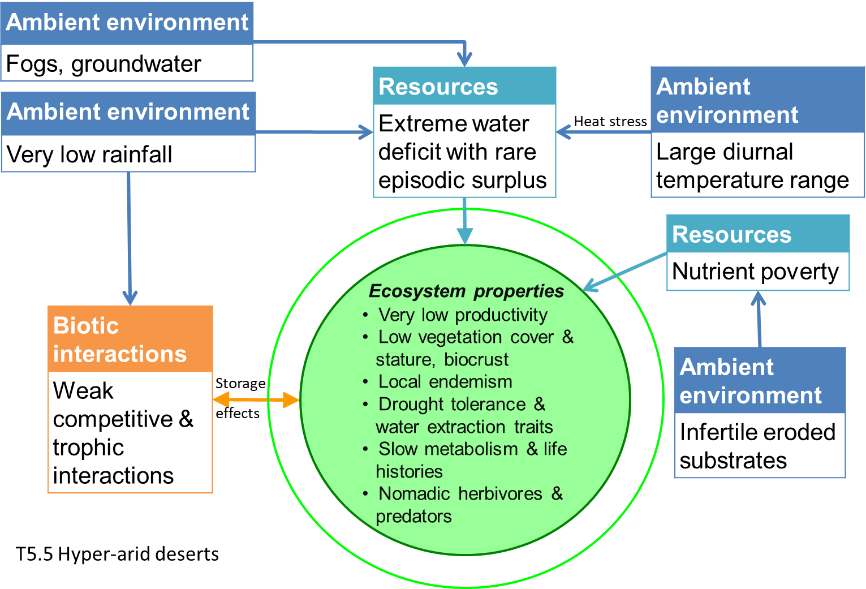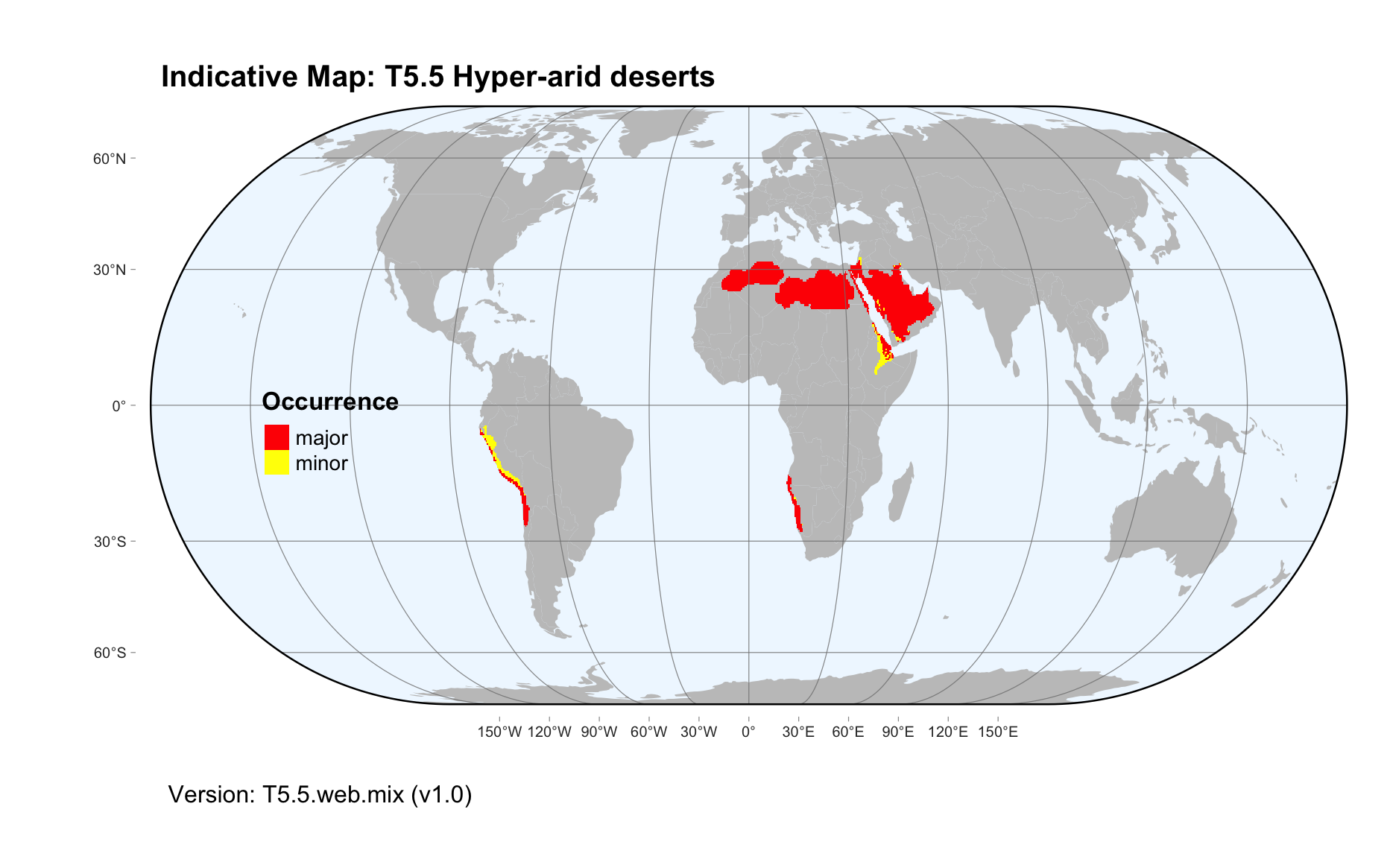Global ecosystem typology
Alternative site for the Global ecosystem typology with additional information for ecosystem profiles and indicative maps.
This site is maintained by jrfep
T5.5 Hyper-arid deserts
Biome: T5. Deserts and semi-deserts biome
Contributors:
(texts)
The most extreme of all desert ecosystems, hyper-arid deserts are limited by very dry and often windy conditions with high temperatures and sandy or stony soils. Dry periods may be prolonged for several years. Vegetation is characterised by very low densities of small drought-tolerant perennial plants known as xerophytes, very slow growing species with adaptations to drought such as extensive root systems and water storage tissues. Some of these plants may acquire much of their moisture from fogs. Ephemeral plants occur in some regions, but are less common than in other desert systems. Microbial biofilms are important decomposers. Drought tolerant reptiles and invertebrates are the main faunal groups, along with occasional nomadic mammals and birds, in simple foodwebs.
Key Features
Very sparsely vegetated ecosystems in areas with very low or no precipitation; very low productivity and simple trophic structures; low diversitybut high endemism.
Overview of distribution
Driest parts of the Sahara-Arabian, Atacama, and Namib deserts in subtropical latitudes.
Profile versions
- v1.0 (2020-01-20): MG Tozer; D Faber-Langendoen; DA Keith
- v2.0 (2020-05-31): MG Tozer; D Faber-Langendoen; DA Keith
- v2.01 ():
- v2.1 (2022-04-06): MG Tozer; D Faber-Langendoen; DA Keith Full profile available at official site
Main references
Selected references for this functional group:
Zablocki O, Adriaenssens EM, Cowan D (2016) Diversity and ecology of viruses in hyperarid desert soils Applied and Environmental Microbioly 82: 770 –777 DOI:10.1128/aem.02651-15
Rundel P W, Dillon MO, Palma B, Mooney HA, Gulmon SL, Ehleringer JR (1991) The phytogeography and ecology of the coastal Atacama and Peruvian deserts Aliso 13(1): 2 DOI:10.5642/aliso.19911301.02
Diagrammatic assembly model

Maps
Maps are indicative of global distribution patterns are not intended to represent fine-scale patterns. The maps show areas of the world containing major (coloured red) or minor occurrences (coloured yellow) of each ecosystem functional group. See general notes on maps.
There are 2 alternative versions of the indicative map for this functional group, please compare description and sources below.
T5.5.IM.mix_v1.0
Datasets
- Resolve-Ecoregions-2017
- EarthEnv-LandCover-v1.0
Map references
Dinerstein E, Olson D, Joshi A, Vynne C, Burgess ND, Wikramanayake E, Hahn N, Palminteri S, Hedao P, Noss R, Hansen M, Locke H, Ellis EE, Jones B, Barber CV, Hayes R, Kormos C, Martin V, Crist E, Sechrest W, Price L, Baillie JEM, Weeden D, Suckling K, Davis C, Sizer N, Moore R, Thau D, Birch T, Potapov P, Turubanova S, Tyukavina A, de Souza N, Pintea L, Brito JC, Llewellyn Barnekow Lillesø JP, van Breugel P, Graudal L, Voge M, Al-Shammari KF, Saleem M (2017) An Ecoregion-Based Approach to Protecting Half the Terrestrial Realm, BioScience 67: 534–545. DOI:10.1093/biosci/bix014. Data-set available on-line
Tuanmu, M.-N. and W. Jetz (2014) A global 1-km consensus land-cover product for biodiversity and ecosystem modeling Global Ecology and Biogeography 23(9):1031–1045 DOI:10.1111/geb.12182
T5.5.web.mix_v1.0

Datasets
- Resolve-Ecoregions-2017
- EarthEnv-LandCover-v1.0
Map references
Dinerstein E, Olson D, Joshi A, Vynne C, Burgess ND, Wikramanayake E, Hahn N, Palminteri S, Hedao P, Noss R, Hansen M, Locke H, Ellis EE, Jones B, Barber CV, Hayes R, Kormos C, Martin V, Crist E, Sechrest W, Price L, Baillie JEM, Weeden D, Suckling K, Davis C, Sizer N, Moore R, Thau D, Birch T, Potapov P, Turubanova S, Tyukavina A, de Souza N, Pintea L, Brito JC, Llewellyn Barnekow Lillesø JP, van Breugel P, Graudal L, Voge M, Al-Shammari KF, Saleem M (2017) An Ecoregion-Based Approach to Protecting Half the Terrestrial Realm, BioScience 67: 534–545. DOI:10.1093/biosci/bix014. Data-set available on-line
Tuanmu, M.-N. and W. Jetz (2014) A global 1-km consensus land-cover product for biodiversity and ecosystem modeling Global Ecology and Biogeography 23(9):1031–1045 DOI:10.1111/geb.12182
Check: the Glossary / Profile structure / the public document